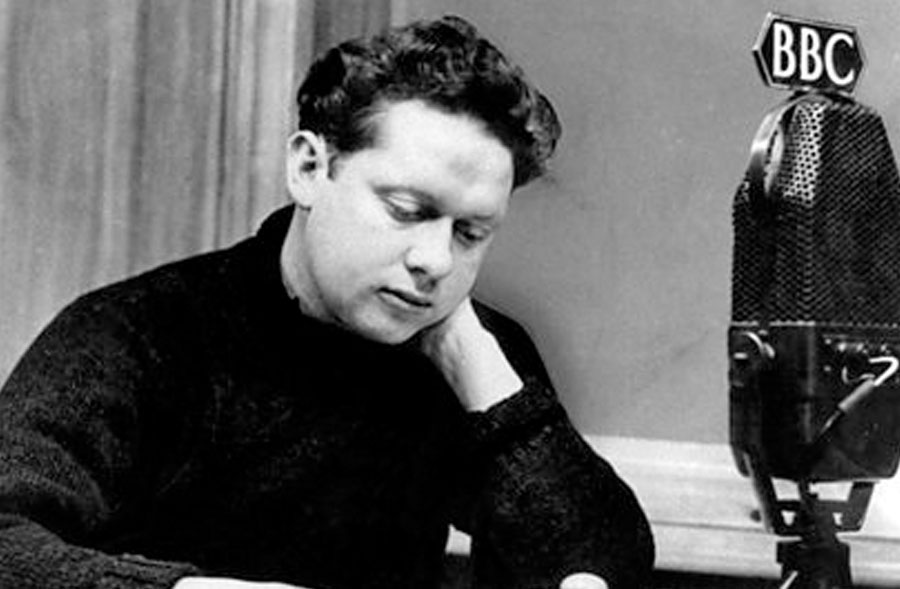
Had Dylan Thomas lived he would have turned 100 on October 27th, 2014. He died on November 9, 1953 in New York. Thomas was known not just for his poetry but for his readings of his works. As we celebrate the life and death of this celebrated poet, we invite you to pause to listen to some of his readings of his most notable works.
DO NOT GO GENTLE INTO THAT GOOD NIGHT
A REFUSAL TO MOURN THE DEATH, BY FIRE, OF A CHILD IN LONDON
UNDER MILK WOOD
______________________________________________________
If Dylan Thomas had not died at the age of 39, he would have celebrated his one hundredth birthday in October of this year. Instead, the fiery, hard-living, Welsh poet met an early death in a New York hospital in 1953. He had come to the United States to embark on his fourth speaking tour, but the tour was not fated to happen.
The question, raised by many at the time and fiercely debated ever since, is whether America also killed him. During his four American tours, between 1950 and 1953, Thomas put on a better show than any visiting writer since Dickens. His rich, honeyed baritone, and a dramatic instinct honed by years of broadcasting, made him a powerful reader of his own and others’ poems. But what drew crowds from New York to San Francisco, and on every college campus in between, was not just the performance; it was the possibility that Thomas would finally, irreparably, crack up. Elizabeth Hardwick remembered how professors and students alike were mesmerized by his alcoholic high-wire act: “Would he arrive only to break down on the stage? Would some dismaying scene take place at the faculty party? Would he be offensive, violent, obscene? These were alarming and yet exciting possibilities.”
Read the full story: RECKLESS ENDANGERMENT–The making and unmaking of Dylan Thomas.
Thomas, who had a history of lung trouble, grew ill before leaving England, but his condition was aggravated by his drinking habits and the smog that blanketed New York (by the end of November 200 people had died from the smog). He barely struggled through practices and performances of his play “Under Milk Wood” and was given injections by a physician to keep him going. His health continued to decline, forcing him to stay in his hotel room until his publicist finally took him to a hospital, where he slipped into a coma and died several days later on November 9.
Long surrounded by mystery, Thomas’s death was first explained as the result of his hard-drinking ways. His last words were said to be a boast that he had drunk “18 straight whiskies; I think it’s a record.” Eighteen was likely an exaggeration on his part. An autopsy showed a fatty liver, brain swelling, and pneumonia. Scholars now think that untreated pneumonia and bronchitis were the cause of the poet’s death, exacerbated by injections of morphine from the physician and his general poor health due to the drinking and his smoking. Other theories offered through the years have included the poet having been mugged, drug abuse, and undiagnosed diabetes.

Thomas’s body was returned to Wales, where he was buried at St. Martin’s church in Laugharne. Caitlin was buried beside him after her death in 1994. He received a plaque in poet’s corner in Poet’s Corner in Westminster Abbey in 1982.
Death had long dwelt in the poet’s mind, furnishing the subject matter for some of his most widely read poems. First published in 1933 when the poet was only 19, his poem “Death shall have no dominion” has remained popular with readers because of its optimism in the face of the ultimate fate. “A Refusal to Mourn the Death, by Fire, of a Child in London” was inspired by a newspaper article about a girl who was killed during an air raid on London in World War II and contains the famous line, “after the first death, there is no other.”
While he had written a eulogy for his aunt called “After the funeral,” it is his poetic admonition to his dying father that is more widely remembered and read today. In 1952 David Thomas, a once strong man who had taught school and been one of Dylan’s teachers, lay dying of pneumonia. “Do Not Go Gentle Into That Good Night” exhorted the elder Thomas to “rage, rage, against the dying of the light” and to “not go gentle into that good night.” The poem, written in a rigid structure called a villanelle, is fierce and haunting and has often been quoted in movies and TV shows, as well as inspiring paintings and other works of fiction.
In the 1940s Thomas produced many recordings with the BBC and which still survive today. His lilting reading style and Welsh accent attracted many listeners and helped make his American tours successful before his untimely death. An internet search will result in many places to listen to or watch his readings, but below are links to some of the works mentioned here.
Got something to add to this story? Please share it in the comments.
LEARN MORE ABOUT DYLAN THOMAS










